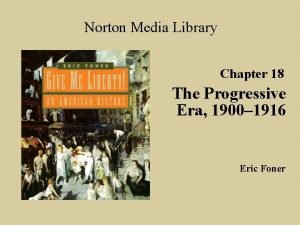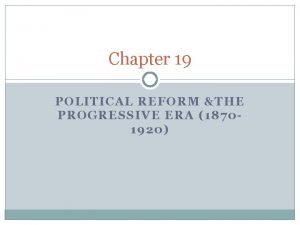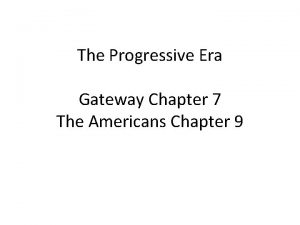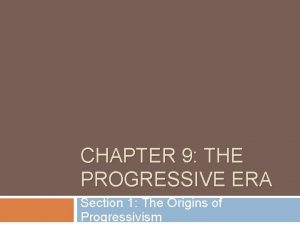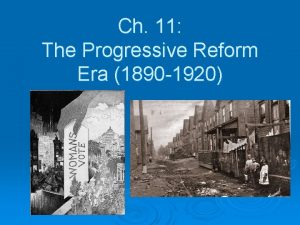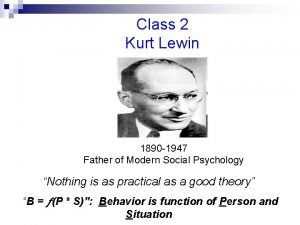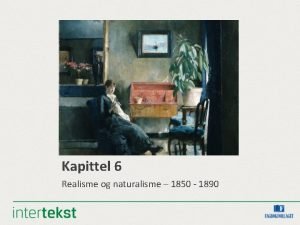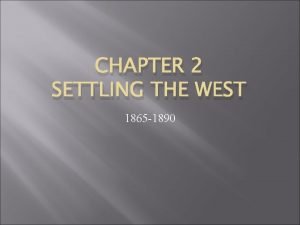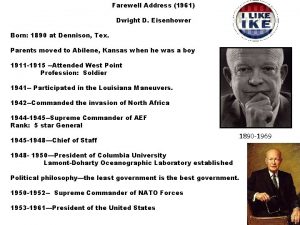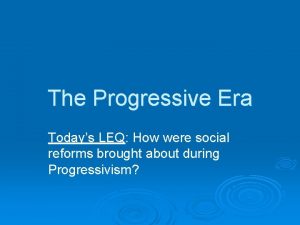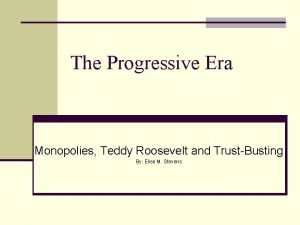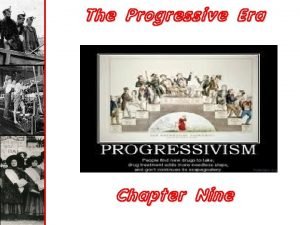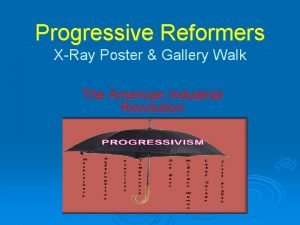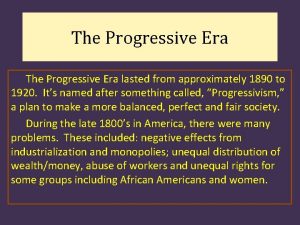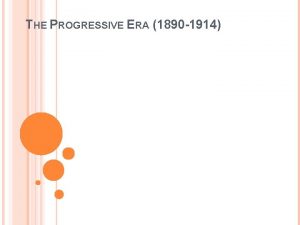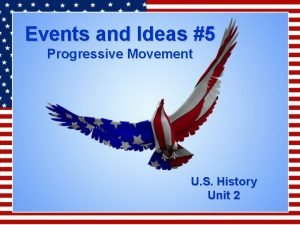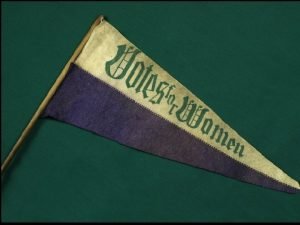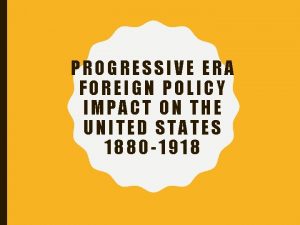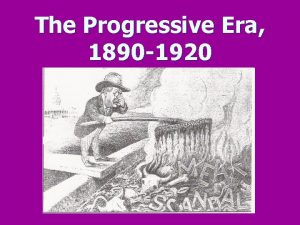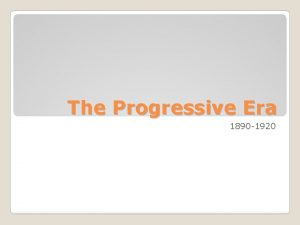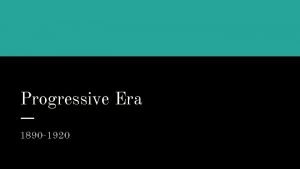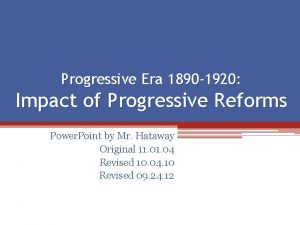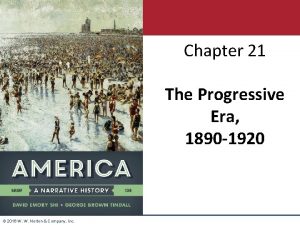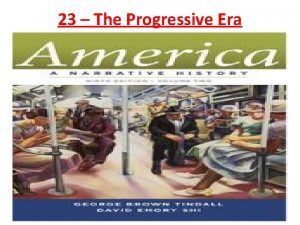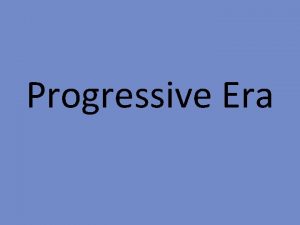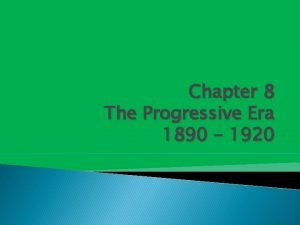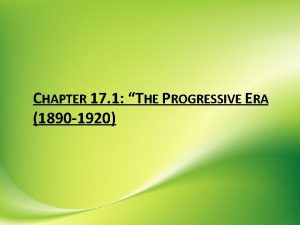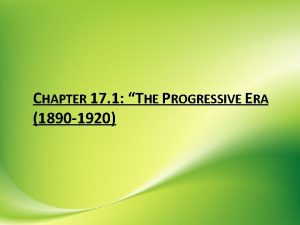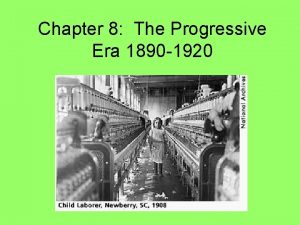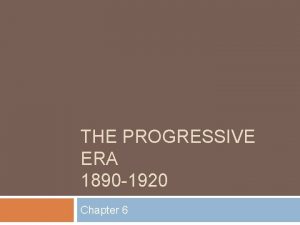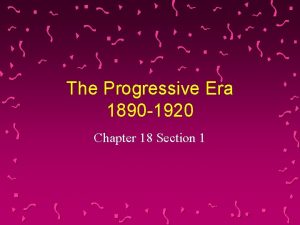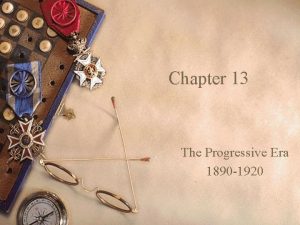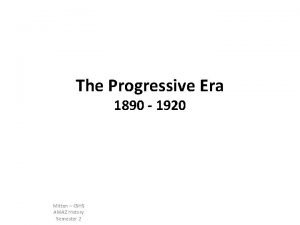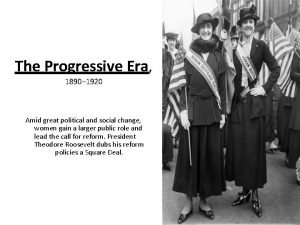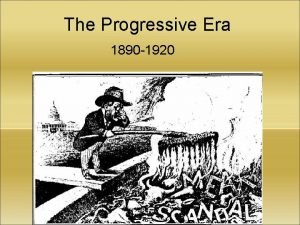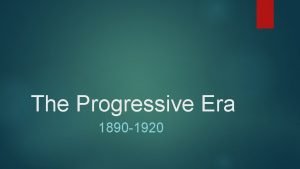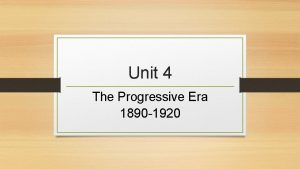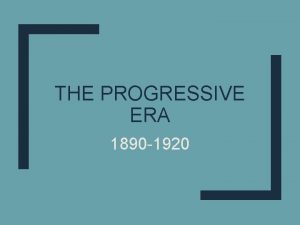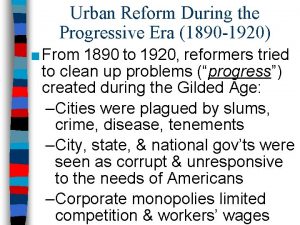Chapter 21 The Progressive Era 1890 1920 2016




































- Slides: 36

Chapter 21 The Progressive Era, 1890 -1920 © 2016 W. W. Norton & Company, Inc.

Social Problems Spur Progressive Reform © 2016 W. W. Norton & Company, Inc.

Elements of Reform • The Varied Sources of Progressivism • The social unrest at the end of the 19 th century bled over into the twentieth. • Now, business owners were more interested in securing changes to avoid the problems they had experienced beforehand. Known as the Progressive Era, it was marked by a growth in the middle and upper-middle classes. • Populism was one of the catalysts of this era. The publications of the Mugwumps on the reform of the civil service shifted the focus of society to ways to reform and improve the systems. © 2016 W. W. Norton & Company, Inc.

Early Efforts at Urban Reform • State Reforms and Legal Backlash • The state was the first entity to see a need for regulating big business and working conditions. • Many of these states’ actions were overturned when the Supreme Court used the 14 th Amendment to thwart. • Muckrakers • Investigative journalists found career reporting on working conditions. • Journalists were called muckrakers. © 2016 W. W. Norton & Company, Inc.

Cover of Mc. Clure’s, 1902 © 2016 W. W. Norton & Company, Inc.

The Social Gospel • Christian Crusaders for Reform • Through the social gospel, Christians and Jews provided the crucial source of energy for progressive reformers. Relying on the teaching of their faith, they worked to promote laws such as establishing a minimum wage and a shorter work day. • Religious Reformers • One principal reformer was Washington Gladden, a Congregationalist minister in Springfield, Massachusetts. He argued that the greatest thing Christianity should emphasize is the teaching to love thy neighbor as thyself. His publications and teachings would make him a leader of the reform movement. © 2016 W. W. Norton & Company, Inc.

Early Efforts at Urban Reform, continued • The Settlement House Movement • To combat the slums and tenement houses, workers such as Jane Addams and Ellen Starr created residential community centers known as settlement houses. • These facilities were mainly staffed by middle-class, college-educated women who had few other outlets for meaningful work. • They worked to improve the lives of their dwellers through meeting their practical needs such as arranging for nurseries for working women, kindergartens, and neighborhood programs for children. • Women’s Employment and Activism • With the rise of industrialization, women soon became more common in the workplace. By 1910, 7. 8 million women worked outside the home. In 1869, Susan B. Anthony and Elizabeth Cady Stanton found the National Woman Suffrage Association to secure nationally the right of females to vote. They would not be successful until the passage of the Nineteenth Amendment in 1920. © 2016 W. W. Norton & Company, Inc.

Jane Addams © 2016 W. W. Norton & Company, Inc.

East Meets West © 2016 W. W. Norton & Company, Inc.

Women’s Suffrage, 1869– 1914 © 2016 W. W. Norton & Company, Inc.

Features of Progressivism • Democracy-During the Progressive Era, this system would be supplanted by the direct primary system, in which every party member was allowed to vote for a candidate. Also during this time the initiative and referendum were introduced and in some states were allowed to directly pass laws or force the legislature to consider legislation. • Efficiency-In 1911, the concept of “Taylorism” was introduced, which promoted efficiency in the workplace to allow workers to accomplish more during less time. • Anti-Trust Regulation • Efforts under the Sherman Anti-Trust Act of 1890 to control big business had proved more symbolic than effective. Attempts to reestablish small firms in areas in which a trust had a monopoly failed. • Social Justice- efforts were rampant to regulate child labor and alcohol consumption. © 2016 W. W. Norton & Company, Inc.

Frances Elizabeth Willard-founded WCTU © 2016 W. W. Norton & Company, Inc.

Child Labor –children shucking oysters 1913 © 2016 W. W. Norton & Company, Inc.

Features of Progressivism, continued • Progressivism and Religion- Christians and Jews found a common aspect in trying to link Progressivism and religion. • Prohibition • Another aspect of progressivism was the Prohibition movement. Reformers hoped that closing saloons and making alcohol illegal would deprive political bosses of a valuable tool for recruiting people to their cause. © 2016 W. W. Norton & Company, Inc.

Roosevelt’s Progressivism • Executive Action • In 1902, Roosevelt embraced a “Square Deal” for Americans, in which the regulating of existing anti-trust legislation would be upheld and more powerful enforcement powers would be established. Roosevelt would often support the regulation of trusts over their dissolution, as he viewed this to be more efficient. • The 1902 Coal Strike-When coal workers in Pennsylvania and West Virginia went on strike until a 20 percent pay increase was granted, Roosevelt did not follow in Rutherford Hayes’ and Grover Cleveland’s footsteps. They had immediately sent in troops to restore the mines. Roosevelt attempted to broker a resolution between the two sides until the owners refused to accommodate. Only then did he threaten to take over the mines, which caused the owners to relent. • Expanding Federal Power-Roosevelt’s administration initiated nearly twenty-five anti-trust suits. Through these cases, the Interstate Commerce Commission, created by the Sherman Anti-Trust Act, was further strengthened and made more relevant. © 2016 W. W. Norton & Company, Inc.

Bad Meat © 2016 W. W. Norton & Company, Inc.

Roosevelt’s Second Term • Legislative Leadership • In 1904, the Republicans nominated Roosevelt for his first term as president. He would defeat the Democrat Judge Alton B. Parker by an extremely lopsided victory. Roosevelt would use his mandate as a reason to further pursue his progressive policies. He would attempt to regulate railroads, meat packers, food processors, and drugs and patent medicines. • Environmental Conservation • Perhaps Roosevelt’s greatest legacy came in the form of conservation of public lands. • Under his administration, Yellowstone National Park was created and the Division of Forestry was established to control the national parks. Special programs to provide for the distribution of water to the arid West were also approved. © 2016 W. W. Norton & Company, Inc.

Square Deal-1906 cartoon on Standard Oil © 2016 W. W. Norton & Company, Inc.

From Roosevelt to Taft • Tariff Reform • Roosevelt would step down after his first full term and support William Howard Taft as the Republican candidate in the 1908 election. The Democrats once again nominated William Jennings Bryan. Taft easily defeated Bryan. Once in office, Taft departed from Roosevelt and the Republicans on tariff reform and supported lowering it. Lacking Roosevelt’s political skill, Taft ended up alienating the Republican party and signed a tariff bill that made things worse. • Richard Ballinger and Gifford Pinchot • Taft’s secretary of the interior, Richard Ballinger, was opposed to Roosevelt’s establishment of national parks. He would open up land for the construction of waterpower sites that had been marked for conservation. At the same time, he opened up land for coal mining companies that sold some of the land to other developers. Pinchot reported this to Taft, who chose to do nothing. He then went to the press. Taft fired him for insubordination. © 2016 W. W. Norton & Company, Inc.

William Howard Taft © 2016 W. W. Norton & Company, Inc.

4. Progressive reform in Congress • the Democrats swept the congressional elections of 1910; the new Democratic majority in the House, working with progressive Republicans in the Senate, achieved a number of key reforms • included legislation to regulate mine and railroad safety, to create a Children’s Bureau in the Department of Labor, and to establish an eight-hour workday for federal workers • the Congress sent to the states the 16 th Amendment, which provided for a modest graduated income tax, and the Seventeenth Amendment, which called for the direct election of senators 5. Dollar diplomacy • championed “dollar diplomacy, ” naively believing he could substitute “dollars for bullets” • in the Caribbean, he provoked anti-American feeling by attempting to force commercial treaties on Nicaragua and Honduras, and by dispatching the U. S. Marines to Nicaragua and the Dominican Republic in 1912, pursuant to the Roosevelt Corollary 6. Roosevelt’s criticism • final breach between Taft and Roosevelt came in 1911, when Taft’s attorney general filed an antitrust suit against U. S. Steel, citing Roosevelt’s agreement with the Morgan interests in the 1907 acquisition of Tennessee Coal and Iron. © 2016 W. W. Norton & Company, Inc.

© 2016 W. W. Norton & Company, Inc.

Sideshow Ted © 2016 W. W. Norton & Company, Inc.

IV. Woodrow Wilson and Progressivism at High Tide A. Progressive Insurgency and the Election of 1912 1. The Republican primaries • 1912, Roosevelt challenged Taft for the Republican nomination; but for all • • his popularity, he had lost control of the party machine, and Taft refused to step aside Roosevelt ran in thirteen primaries and won 278 delegates to Taft’s 48, but Taft’s bosses refused to seat the Roosevelt delegates at the Chicago convention Taft won nomination on the first ballot. 2. The Bull Moose Party planks called for woman suffrage, presidential primaries, conservation of natural resources, a minimum wage for women, an end to child labor, workers’ compensation, social security, and a federal income tax; nicknamed the Bull Moose Party. 3. Four Progressives Democrats were delighted at the split in the Republican ranks; smelled victory and nominated Woodrow Wilson; voters in 1912 chose from four candidates who claimed to be progressives—Taft, Roosevelt, Woodrow Wilson, and the Socialist candidate, Eugene V. Debs. 4. “The new nationalism” versus “The new freedom” Wilson’s New Freedom, based on the Democratic principles of limited government and states’ rights, promised to use antitrust legislation to get rid of big corporations and give small businesses and farmers better opportunities. Wilson and Roosevelt fought it out, but in the end, the Republican vote was split while the Democrats remained united; Wilson won a decisive victory in the electoral college; Taft received only eight electoral votes. © 2016 W. W. Norton & Company, Inc.

Woodrow Wilson’s Rise • The Election of 1912 • Wilson had served as president of Princeton University and a governor of New Jersey before winning the presidency. • In the 1912 campaign, Roosevelt was shot in the chest by a mentally disturbed man before a speech. • Although injured, he gave his speech anyway, and commented that it took more than a bullet to kill a bull moose. • The image was so vivid that Roosevelt’s party adopted the bull moose as their icon and Taft quickly lost ground. • Still, the division between the two Republicans allowed Wilson to win with a majority of electoral votes, though only a plurality of popular votes. © 2016 W. W. Norton & Company, Inc.

Woodrow Wilson © 2016 W. W. Norton & Company, Inc.

The Election of 1912 © 2016 W. W. Norton & Company, Inc.

Woodrow Wilson’s Progressivism • The Tariff- Wilson’s first test of leadership was the passage of the Underwood-Simmons Tariff in 1913. It reduced duties on most goods and lowered the average duty from about 37 to 29 percent. Also at this time, the newly ratified Sixteenth Amendment was placed into effect and a 1 percent tax on income over $3, 000 was in place. -lowered rates by 15 percent to compensate for lost revenue, the House approved a moderate federal income tax. © 2016 W. W. Norton & Company, Inc.

IV. Woodrow Wilson B. Wilson’s Reforms: Tariff, Banking, and the Trusts 2. The Federal Reserve Act • • Wilson was concerned about J. P. Morgan and Company’s control of 341 directorships in 112 corporations and control of more than $22 billion in assets the Federal Reserve Act of 1913 was the most significant domestic legislation of Wilson’s presidency established a national banking system privately controlled but regulated and supervised by a Federal Reserve Board appointed by the president gave the nation its first efficient banking and currency system, provided for a greater degree of government control over banking, and made currency more elastic and credit adequate for the needs of business and agriculture. C. Wilson, Reluctant Progressive 1. “Special privileges to none” 2. About face in 1916 • • appointed progressive Louis Brandeis to the Supreme Court, threw his support behind legislation to obtain rural credits for farmers, supported workers’ compensation and the Keating-Owen child-labor law, and encouraged Congress to establish an eight-hour day on the railroads reform, along with his pledge to keep the country out of World War I, helped him win reelection in 1916. © 2016 W. W. Norton & Company, Inc.

Woodrow Wilson’s Progressivism, continued • Anti-Trust Laws • Wilson’s presidential plan was known as the New Freedom. The chief aspect of this plan was trust-busting. In 1914, the Federal Trade Commission was created with strong powers to regulate trusts. • Social Justice- believed business could be controlled and society would adjust • Progressivism for Whites Only • showed little concern for the plight of African Americans. He did denounce the Ku Klux Klan for its reign of terror. © 2016 W. W. Norton & Company, Inc.

New Freedom, Old Rules © 2016 W. W. Norton & Company, Inc.

Womens’ Rights • The Women’s Movement • Women gained the right to vote in federal elections with the passage of the Nineteenth Amendment in 1920. Following World War I, and the contribution made by women in the workforce, Wilson renounced his reservations about the amendment and publicly supported it. • principally in traditional occupations, as secretaries, dressmakers, and clerks. • Margaret Sanger and Birth Control • Sanger was a nurse who pushed for the distribution of birth control information to women in the US to prevent unwanted pregnancies. • She alienated supporters when she began to lobby for the forced sterilization of mentally incompetent people and those with certain hereditary conditions. © 2016 W. W. Norton & Company, Inc.

Alice Paul © 2016 W. W. Norton & Company, Inc.

Resurgence of Progressivism • Labor Legislation • After World War I broke out in Europe in 1914, Wilson, who desired another term, returned his attention to reform. • He promoted labor and farm reforms to shore up these areas. • During this time, the eight-hour workday for railroad workers was upheld by the Supreme Court and child labor was restricted for those under age fourteen. • During Wilson’s first administration, progressivism reached its high point © 2016 W. W. Norton & Company, Inc.

Limits of Progressivism • Displays of Paradox and Irony • Progressivism was largely a middle-class movement in which the poor or those who chose not to organize had no say. © 2016 W. W. Norton & Company, Inc.

This concludes the Lecture Power. Point presentation for Chapter 21 The Progressive Era Please visit the Student Site for more resources: http: //wwnorton. com/college/history/america 10/ © 2016 W. W. Norton & Company, Inc.
 Chapter 18 the progressive era
Chapter 18 the progressive era Chapter 19 political reform and the progressive era
Chapter 19 political reform and the progressive era Gateway to us history chapter 7 the progressive era
Gateway to us history chapter 7 the progressive era Chapter 9 the progressive era section 1 answers
Chapter 9 the progressive era section 1 answers Chapter 11 the progressive reform era
Chapter 11 the progressive reform era Present progressive passive.
Present progressive passive. Past progressive affirmative
Past progressive affirmative Function of present perfect
Function of present perfect Chapter 23 activity: coping with change, 1920-1929
Chapter 23 activity: coping with change, 1920-1929 Motives of old imperialism
Motives of old imperialism Kirjanik 1890-1952
Kirjanik 1890-1952 Agnosia associativa
Agnosia associativa Kurt lewin (1890-1947)
Kurt lewin (1890-1947) Penholder tutuşu
Penholder tutuşu The population of smallville in the year 1890 was 6250
The population of smallville in the year 1890 was 6250 The population of smallville in the year 1890 was 6250
The population of smallville in the year 1890 was 6250 Det moderne gjennombrudds dramaer
Det moderne gjennombrudds dramaer 1890 computer
1890 computer Chapter 2 settling the west
Chapter 2 settling the west Rizal in london paris brussels and madrid
Rizal in london paris brussels and madrid Paano natapos ni rizal ang el filibusterismo
Paano natapos ni rizal ang el filibusterismo Ano ang oral na dimensyon
Ano ang oral na dimensyon Born 1890
Born 1890 Agosto 6, 1891
Agosto 6, 1891 Keynes marshall
Keynes marshall Progressive era leq
Progressive era leq What are mukrakers
What are mukrakers Progressive era monopolies
Progressive era monopolies What scandalous practices did upton
What scandalous practices did upton Progressive era posters
Progressive era posters Initiative progressive era definition
Initiative progressive era definition The progressive era lasted from
The progressive era lasted from When was the progressive era? *
When was the progressive era? * John dewey progressive era
John dewey progressive era Progressive era worksheets
Progressive era worksheets Progressive era
Progressive era Pros and cons of big stick diplomacy
Pros and cons of big stick diplomacy
